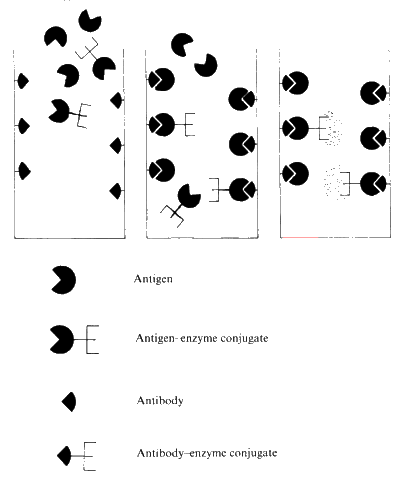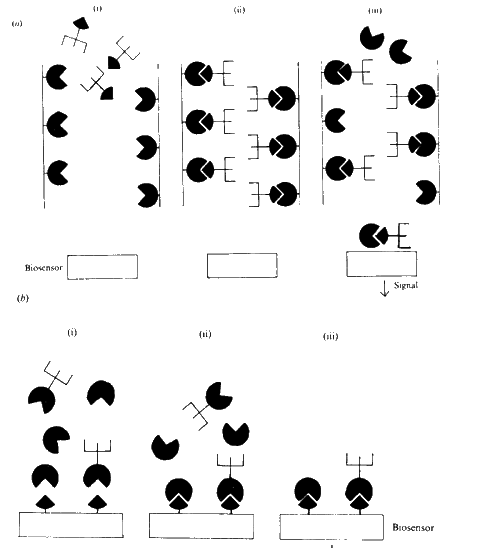|
|
ImmunosensorsBiosensors may be used in conjunction with enzyme-linked immunosorbent assays (ELISA). The principles behind the ELISA technique is shown in Figure 6.9. ELISA is used to detect and amplify an antigen-antibody reaction; the amount of enzyme-linked antigen bound to the immobilised antibody being determined by the relative concentration of the free and conjugated antigen and quantified by the rate of enzymic reaction. Enzymes with high turnover numbers are used in order to achieve rapid response. The sensitivity of such assays may be further enhanced by utilising enzyme-catalysed reactions which give intrinsically greater response; for instance, those giving rise to highly coloured, fluorescent or bioluminescent products. Assay kits using this technique are now available for a vast range of analyses.
Figure 6.9. Principles of a direct competitive ELISA. (i) Antibody, specific for the antigen of interest is immobilised on the surface of a tube. A mixture of a known amount of antigen-enzyme conjugate plus unknown concentration of sample antigen is placed in the tube and allowed to equilibrate. (ii) After a suitable period the antigen and antigen-enzyme conjugate will be distributed between the bound and free states dependent upon their relative concentrations. (iii) Unbound material is washed off and discarded. The amount of antigen-enzyme conjugate that is bound may be determined by the rate of the subsequent enzymic reaction. Recently ELISA techniques have been combined with biosensors, to form immunosensors, in order to increase their range, speed and sensitivity. A simple immunosensor configuration is shown in Figure 6.10 (a), where the biosensor merely replaces the traditional colorimetric detection system. However more advanced immunosensors are being developed (Figure 6.10 ( b)) which rely on the direct detection of antigen bound to the antibody-coated surface of the biosensor. Piezoelectric and FET-based biosensors are particularly suited to such applications.
Figure 6.10. Principles of immunosensors. (a)(i) A tube is coated with (immobilised) antigen. An excess of specific antibody-enzyme conjugate is placed in the tube and allowed to bind. (a)(ii) After a suitable period any unbound material is washed off. (a)(iii) The analyte antigen solution is passed into the tube, binding and releasing some of the antibody-enzyme conjugate dependent upon the antigen's concentration. The amount of antibody-enzyme conjugate released is determined by the response from the biosensor. (b)(i) A transducer is coated with (immobilised) antibody, specific for the antigen of interest. The transducer is immersed in a solution containing a mixture of a known amount of antigen-enzyme conjugate plus unknown concentration of sample antigen. (b)(ii) After a suitable period the antigen and antigen-enzyme conjugate will be distributed between the bound and free states dependent upon their relative concentrations. (b)(iii) Unbound material is washed off and discarded. The amount of antigen-enzyme conjugate bound is determined directly from the transduced signal.
This page was established in 2004 and last updated by Martin
Chaplin |

